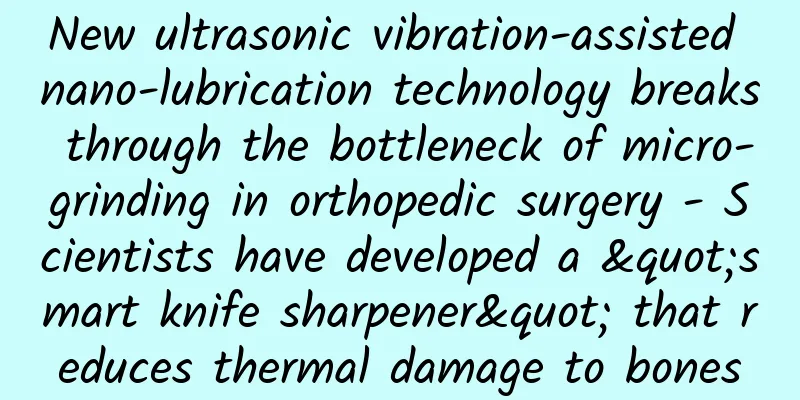New ultrasonic vibration-assisted nano-lubrication technology breaks through the bottleneck of micro-grinding in orthopedic surgery - Scientists have developed a "smart knife sharpener" that reduces thermal damage to bones

|
In orthopedic surgery, precise bone grinding is a key step in determining the success or failure of the operation. However, traditional grinding technology is prone to bone thermal necrosis and peripheral nerve damage due to problems such as high temperature and high grinding force, which has become a technical bottleneck that has troubled surgeons for many years. Recently, Qingdao University of Technology in China and a multinational scientific research team published a major research result in "Frontiers in Mechanical Engineering", proposing an innovative technology called "Ultrasonic Vibration Assisted Nanojet Mist Cooling (U-NJMC)", which successfully reduced bone grinding force by more than 75% and controlled the temperature below 26.2°C, providing a safer and more efficient solution for clinical surgery. Dilemma of traditional technology: Dual challenges of high temperature and limited field of view As a supporting structure of the human body, bones have complex anisotropic characteristics, and their mechanical properties in different directions vary significantly. Due to the lack of cooling in traditional dry grinding, the temperature of the grinding area can quickly rise to above 47°C, which will cause thermal necrosis of bone cells in just 1 minute; although drip cooling can reduce the temperature, a large amount of saline will blur the surgical field of view and increase the difficulty of operation. In addition, the debris generated by grinding is easy to adhere to the tool, further exacerbating friction and temperature rise. The existing micro-quantity lubrication (MQL) technology uses atomized lubricant for cooling, which is environmentally friendly but cannot meet the needs of high-intensity surgery due to its limited cooling capacity. How to achieve efficient cooling without affecting the field of vision has become a technical problem that needs to be overcome urgently. Technological innovation: the combination of ultrasonic vibration and nanoparticles The U-NJMC technology proposed by the research team cleverly combines the two core advantages of ultrasonic vibration (UV) and nano-jet mist cooling (NJMC): Ultrasonic vibration "drag reduction" : Through 20 kHz high-frequency vibration, the grinding tool and the bone are separated periodically, reducing the contact time and thus reducing the average friction. Experiments show that ultrasonic vibration alone can reduce the grinding force by 53.1% and the temperature by 9.6%. Nano-lubrication "cooling" : Add 20 nanometer silicon dioxide (SiO2) particles to physiological saline to form nanofluid. These particles convert sliding friction into rolling friction through the "micro-bearing rolling effect" and "deposition film lubrication" mechanisms, while enhancing heat conduction efficiency. Data shows that nano-lubrication alone can reduce grinding temperature by 33.3%. When the two work together, U-NJMC shows amazing results: compared with dry grinding, the normal grinding force is reduced from 5.59 N to 1.39 N (a decrease of 75.1%), the friction coefficient is reduced by 31.3%, the specific grinding energy consumption is reduced by 83%, and the temperature is stabilized at 26.2°C, which is far below the thermal damage threshold. Experimental verification: Multi-dimensional data demonstrates technical advantages The study used bovine tibia as the experimental object and compared the performance differences of six grinding conditions (dry grinding, drip irrigation, ultrasonic, MQL, NJMC, U-NJMC): Grinding force : The normal force and tangential force of U-NJMC are only 1/4 of those of traditional methods, which greatly reduces the mechanical damage of surgical instruments to bones. Temperature control : The grinding temperature of U-NJMC is 33.5% lower than that of ultrasound alone and 10% lower than that of nano-lubrication alone, effectively avoiding the risk of bone cell necrosis and nerve damage. Improved energy efficiency : The specific grinding energy (energy consumption per unit volume of material removed) is reduced to 0.42×10⁴ J/mm³, which saves 72.7% energy compared to drip irrigation, significantly improving surgical efficiency. Clinical value: opening up a new path for precision orthopedic surgery The breakthrough of this technology is that it combines ultrasonic dynamics with the characteristics of nanomaterials for the first time, solving the contradiction between cooling and vision in traditional technology. Nano-SiO₂ particles are not only safe and biodegradable, but can also carry drug ingredients through surface modification, continuously promoting bone repair after surgery. In addition, the cavitation effect generated by ultrasonic vibration can accelerate the discharge of debris, keep the tool clean, and further extend the life of the instrument. The research team said that U-NJMC has verified the safety in small animal experiments, and the next step will be to promote clinical transformation. In the future, this technology is expected to be applied to high-precision surgeries such as skull repair and joint replacement, shortening the recovery period for patients and reducing the risk of complications. Outlook: The advent of the era of intelligent grinding With the cross-integration of biomaterials and mechanical engineering, orthopedic surgery is moving towards "minimally invasive" and "intelligent". The success of U-NJMC technology not only provides a new paradigm for bone processing, but also provides a reference for the precision processing of other hard and brittle biomaterials (such as teeth and artificial joints). Scientists predict that the "intelligent grinding system" that combines real-time temperature monitoring and adaptive parameter adjustment may become the core development direction of the next generation of surgical instruments. This study once again proves that innovation in basic science is often the source of disruptive medical progress. When nanoparticles and ultrasound dance together on the operating table, humans are one step closer to the ultimate goal of "non-invasive orthopedic surgery." |
>>: Can washing your hair with amoxicillin cure hair loss? Don't believe it!
Recommend
What is the function of Schefflera chinensis? What is the growth environment of Schefflera chinensis like?
There is a plant whose leaves look like duck feet...
What is the reason for not having menstruation for half a month?
Menstruation is a normal physiological phenomenon...
8 months pregnant belly button pain
The problem of navel pain during the eighth month...
What can women eat to replenish qi and blood and get quick results?
It is a common condition for women to have poor q...
Is it necessary to do a second pregnancy sugar screening?
Many couples are very happy after having a second...
Nausea and vomiting: an uninvited guest after anesthesia surgery
Author: Xiao Peng, Hainan Hospital, Guangdong Pro...
Early symptoms of cervical precancerous lesions
It takes 6-8 years for cervical cancer to develop...
High prolactin but normal ovulation
Some female friends said that they still had no g...
The shape of the labia
Many female friends do not know much about the sh...
How to regulate high blood pressure after childbirth
Hypertension is very common after giving birth an...
Bilibili: A look at the 2D video community based on financial report data
The two-dimensional video community Bilibili (com...
How many years does it usually take for a crabapple to bloom? How should I water a crabapple?
The crabapple flower has a beautiful shape and el...
Uterine intramural nodules
The female uterus is a very important organ for w...
Why do girls urinate frequently?
Urine is a waste product produced during the body...
What will happen if you drink porridge every day during pregnancy? What are the precautions for drinking porridge during pregnancy?
We all know that there are many things to pay att...









